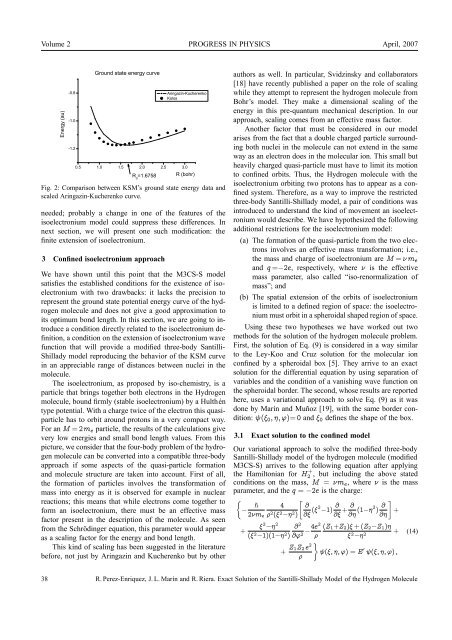ISSUE 2007 VOLUME 2 - The World of Mathematical Equations
ISSUE 2007 VOLUME 2 - The World of Mathematical Equations
ISSUE 2007 VOLUME 2 - The World of Mathematical Equations
You also want an ePaper? Increase the reach of your titles
YUMPU automatically turns print PDFs into web optimized ePapers that Google loves.
Volume 2 PROGRESS IN PHYSICS April, <strong>2007</strong><br />
Fig. 2: Comparison between KSM’s ground state energy data and<br />
scaled Aringazin-Kucherenko curve.<br />
needed; probably a change in one <strong>of</strong> the features <strong>of</strong> the<br />
isoelectronium model could suppress these differences. In<br />
next section, we will present one such modification: the<br />
finite extension <strong>of</strong> isoelectronium.<br />
3 Confined isoelectronium approach<br />
We have shown until this point that the M3CS-S model<br />
satisfies the established conditions for the existence <strong>of</strong> isoelectronium<br />
with two drawbacks: it lacks the precision to<br />
represent the ground state potential energy curve <strong>of</strong> the hydrogen<br />
molecule and does not give a good approximation to<br />
its optimum bond length. In this section, we are going to introduce<br />
a condition directly related to the isoelectronium definition,<br />
a condition on the extension <strong>of</strong> isoelectronium wave<br />
function that will provide a modified three-body Santilli-<br />
Shillady model reproducing the behavior <strong>of</strong> the KSM curve<br />
in an appreciable range <strong>of</strong> distances between nuclei in the<br />
molecule.<br />
<strong>The</strong> isoelectronium, as proposed by iso-chemistry, is a<br />
particle that brings together both electrons in the Hydrogen<br />
molecule, bound firmly (stable isoelectronium) by a Hulthén<br />
type potential. With a charge twice <strong>of</strong> the electron this quasiparticle<br />
has to orbit around protons in a very compact way.<br />
For an M = 2me particle, the results <strong>of</strong> the calculations give<br />
very low energies and small bond length values. From this<br />
picture, we consider that the four-body problem <strong>of</strong> the hydrogen<br />
molecule can be converted into a compatible three-body<br />
approach if some aspects <strong>of</strong> the quasi-particle formation<br />
and molecule structure are taken into account. First <strong>of</strong> all,<br />
the formation <strong>of</strong> particles involves the transformation <strong>of</strong><br />
mass into energy as it is observed for example in nuclear<br />
reactions; this means that while electrons come together to<br />
form an isoelectronium, there must be an effective mass<br />
factor present in the description <strong>of</strong> the molecule. As seen<br />
from the Schrödinger equation, this parameter would appear<br />
as a scaling factor for the energy and bond length.<br />
This kind <strong>of</strong> scaling has been suggested in the literature<br />
before, not just by Aringazin and Kucherenko but by other<br />
authors as well. In particular, Svidzinsky and collaborators<br />
[18] have recently published a paper on the role <strong>of</strong> scaling<br />
while they attempt to represent the hydrogen molecule from<br />
Bohr’s model. <strong>The</strong>y make a dimensional scaling <strong>of</strong> the<br />
energy in this pre-quantum mechanical description. In our<br />
approach, scaling comes from an effective mass factor.<br />
Another factor that must be considered in our model<br />
arises from the fact that a double charged particle surrounding<br />
both nuclei in the molecule can not extend in the same<br />
way as an electron does in the molecular ion. This small but<br />
heavily charged quasi-particle must have to limit its motion<br />
to confined orbits. Thus, the Hydrogen molecule with the<br />
isoelectronium orbiting two protons has to appear as a confined<br />
system. <strong>The</strong>refore, as a way to improve the restricted<br />
three-body Santilli-Shillady model, a pair <strong>of</strong> conditions was<br />
introduced to understand the kind <strong>of</strong> movement an isoelectronium<br />
would describe. We have hypothesized the following<br />
additional restrictions for the isoelectronium model:<br />
(a) <strong>The</strong> formation <strong>of</strong> the quasi-particle from the two electrons<br />
involves an effective mass transformation; i.e.,<br />
the mass and charge <strong>of</strong> isoelectronium are M = ν me<br />
and q =−2e, respectively, where ν is the effective<br />
mass parameter, also called “iso-renormalization <strong>of</strong><br />
mass”; and<br />
(b) <strong>The</strong> spatial extension <strong>of</strong> the orbits <strong>of</strong> isoelectronium<br />
is limited to a defined region <strong>of</strong> space: the isoelectronium<br />
must orbit in a spheroidal shaped region <strong>of</strong> space.<br />
Using these two hypotheses we have worked out two<br />
methods for the solution <strong>of</strong> the hydrogen molecule problem.<br />
First, the solution <strong>of</strong> Eq. (9) is considered in a way similar<br />
to the Ley-Koo and Cruz solution for the molecular ion<br />
confined by a spheroidal box [5]. <strong>The</strong>y arrive to an exact<br />
solution for the differential equation by using separation <strong>of</strong><br />
variables and the condition <strong>of</strong> a vanishing wave function on<br />
the spheroidal border. <strong>The</strong> second, whose results are reported<br />
here, uses a variational approach to solve Eq. (9) as it was<br />
done by Marín and Muñoz [19], with the same border condition:<br />
ψ(ξ0, η, ϕ)= 0 and ξ0 defines the shape <strong>of</strong> the box.<br />
3.1 Exact solution to the confined model<br />
Our variational approach to solve the modified three-body<br />
Santilli-Shillady model <strong>of</strong> the hydrogen molecule (modified<br />
M3CS-S) arrives to the following equation after applying<br />
the Hamiltonian for H + 2 , but including the above stated<br />
conditions on the mass, M = νme, where ν is the mass<br />
parameter, and the q = −2e is the charge:<br />
�<br />
− ℏ 4<br />
2νme ρ2 (ξ2−η 2 �<br />
∂<br />
) ∂ξ (ξ2−1) ∂ ∂<br />
+<br />
∂ξ ∂η (1−η2 ) ∂<br />
�<br />
+<br />
∂η<br />
ξ<br />
+<br />
2 −η 2<br />
(ξ2−1)(1−η2 ∂<br />
)<br />
2<br />
4e2 (Z1+Z2)ξ + (Z2−Z1)η<br />
−<br />
∂ϕ2 ρ ξ2−η 2 +<br />
+ Z1Z2 e2<br />
�<br />
ψ(ξ, η, ϕ) = E<br />
ρ<br />
′ ψ(ξ, η, ϕ) ,<br />
38 R. Perez-Enriquez, J. L. Marín and R. Riera. Exact Solution <strong>of</strong> the Santilli-Shillady Model <strong>of</strong> the Hydrogen Molecule<br />
(14)

















